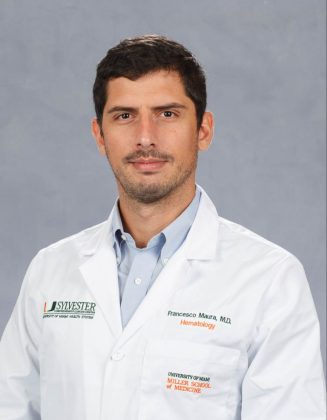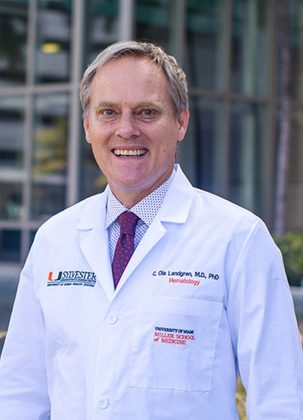|
Getting your Trinity Audio player ready...
|
To create the most effective, personalized treatment plans for patients with Hodgkin lymphoma or other cancers, scientists and clinicians need the clearest picture of the genetic changes leading to the cancer’s development.
That picture, say scientists atSylvester Comprehensive Cancer Center in the University of Miami Miller School of Medicine, comes into much better focus when whole genome sequencing — rather than the current standard, exome sequencing — is used to identify changes driving the cancer.
Exome sequencing, which reads only protein-coding genes, can detect some specific mutations and other variants that propel cancers, but the multicenter team led by researchers at Sylvester and other cancer research centers found that whole genome sequencing (WGS) can read virtually all the mutations in both protein-coding and noncoding regions of the genome, and it can detect other changes that can lead to cancer’s development.
“We found many genomic events that had never been recorded before. It’s the best technology we’ve found to identify new cancer drivers,” said Dr. Craig Moskowitz, physician-in-chief, Oncology Service Line at Sylvester, professor of medicine at the Miller School and a co-author of an article published in Blood Cancer Discovery.
While exome sequencing has been extremely fruitful, detecting point mutations and other variants that propel cancers, it paints an incomplete picture. Mutations in noncoding genomic regions can also govern gene expression. In addition, WGS identifies a wide range of structural variations, including chromothripsis, in which damaged chromosomes look like they’ve been hit by sledgehammers.
The study identified many of these issues in cHL, as well as finding mutational signatures associated with chemotherapy. Perhaps most importantly, WGS provided temporal insights into how the cancers evolved. Reconstructing tumor chronology could play a major role in treatment selection.
“It’s important to know how a tumor developed over time,” said Dr. Francesco Maura, co-leader of the Myeloma Genomic Lab at Sylvester, assistant professor of medicine, and first author of the study. “We need to know which mutations were acquired and in what order. If we prescribe a targeted therapy, we want it to target genomic alterations that are shared throughout the tumor, rather than the subclones that came later and are relatively rare.”
For this proof-of-concept study, the researchers invented a sophisticated system making it possible to isolate and study the rare Hodgkin and Reed Sternberg cells found in classic Hodgkin lymphoma (cHL). They believe this approach, combined with WGS, could provide many new insights into cHL and other cancers.
“Cancers are incredibly complex diseases, and we still have a long way to go before we fully understand them,” said C. Ola Landgren, MD, director of the Myeloma Research Institute, co-leader of Translational and Clinical Oncology Research Program, and co-author on the study. “By leveraging WGS, we can better assess tumor evolution, identify structural issues and hopefully gain new therapeutic insights.”
The research was led by scientists from Sylvester, Memorial Sloan Kettering Cancer Center and Weill Cornell Medical College.
This work was supported by the Children’s Oncology Group, Hartwell Foundation, Gant Family Foundation, Sylvester Comprehensive Cancer Center NCI Core Grant (P30 CA 240139), and Memorial Sloan Kettering Cancer Center NCI Core Grant (P30 CA 008748).
Maura is supported by the American Society of Hematology. Maura and Landgren are supported by the Riney Family Foundation. Lisa Giulino-Roth, MD, a co-author, is supported by the NIH (K08CA219473), Gant Family Foundation, and Hartwell Foundation.
Disclosures/Possible Conflict of Interest: A senior author, from Weill Cornell, is a scientific advisory board member at Merck. Other authors do not have conflicts of interest to declare.
Sylvester Comprehensive Cancer Center, part of UHealth — University of Miami Health System and the University of Miami Miller School of Medicine, is the only National Cancer Institute (NCI) designated and nationally ranked cancer center in South Florida, according to U.S. News & World Report 2022-23 Best Hospitals for Cancer.
ABOUT US:
For more Miami community news, look no further than Miami Community Newspapers. This Miami online group of newspapers covers a variety of topics about the local community and beyond. Miami’s Community Newspapers offers daily news, online resources, podcasts and other multimedia content to keep readers informed. With topics ranging from local news to community events, Miami’s Community Newspapers is the ideal source for staying up to date with the latest news and happenings in the area. Additionally, the newspaper has exclusive Miami community podcasts, providing listeners with an in-depth look into Miami’s culture. Whether you’re looking for local Miami news, or podcasts about the community, Miami’s Community Newspapers has you covered.








